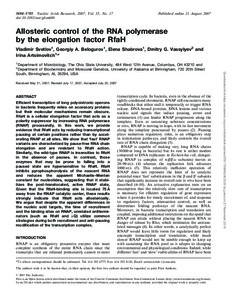Allosteric control of the RNA polymerase by the elongation factor RfaH
Shabrova E; Vassylyev DG; Svetlov V; Belogurov GA; Artsimovitch I
Allosteric control of the RNA polymerase by the elongation factor RfaH
Shabrova E
Vassylyev DG
Svetlov V
Belogurov GA
Artsimovitch I
Julkaisun pysyvä osoite on:
https://urn.fi/URN:NBN:fi-fe2021042714697
https://urn.fi/URN:NBN:fi-fe2021042714697
Tiivistelmä
Efficient transcription of long polycistronic operons in bacteria frequently relies on accessory proteins but their molecular mechanisms remain obscure. RfaH is a cellular elongation factor that acts as a polarity suppressor by increasing RNA polymerase (RNAP) processivity. In this work, we provide evidence that RfaH acts by reducing transcriptional pausing at certain positions rather than by accelerating RNAP at all sites. We show that 'fast' RNAP variants are characterized by pause-free RNA chain elongation and are resistant to RfaH action. Similarly, the wild-type RNAP is insensitive to RfaH in the absence of pauses. In contrast, those enzymes that may be prone to falling into a paused state are hypersensitive to RfaH. RfaH inhibits pyrophosphorolysis of the nascent RNA and reduces the apparent Michaelis-Menten constant for nucleotides, suggesting that it stabilizes the post-translocated, active RNAP state. Given that the RfaH-binding site is located 75 A away from the RNAP catalytic center, these results strongly indicate that RfaH acts allosterically. We argue that despite the apparent differences in the nucleic acid targets, the time of recruitment and the binding sites on RNAP, unrelated antiterminators (such as RfaH and lambdaQ) utilize common strategies during both recruitment and anti-pausing modification of the transcription complex.
Kokoelmat
- Rinnakkaistallenteet [19207]
